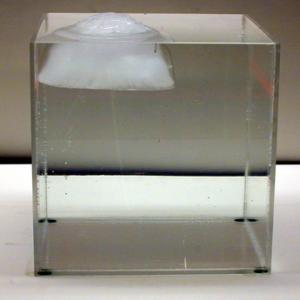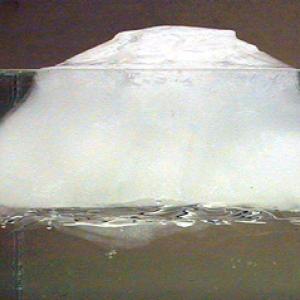College of Liberal Arts & Sciences
4C20.25 - Change of Volume with Change of State - Melting Iceberg
Fill the tank 3/4 full of water then place the ice cube in it. Finish filling the tank to almost overflowing. When this is done right you should see the water level will be above the edge of the tank. The question is, will the tank overflow when the iceberg melts??
- Gary Reich, "Exploding Water Drops", TPT, Vol. 54, #1, Jan. 2016, p. 9.
- Boon Leong Lan, "Does Sea Level Change When a Floating Iceberg Melts?", TPT, Vol. 48, # 5, May 2010, p. 328.
- Paul Hewitt, "Hewitt's Response", TPT, Vol. 46, # 9, December 2008, p. 516.
- Jim McNeil, "'Topped Iceberg' Transcience", TPT, Vol. 46, # 9, December 2008, p. 516.
- "Figuring Physics", TPT, Vol. 46, # 3, March 2008, p. 179.
- "Figuring Physics", TPT, Vol. 35, # 5, May 1997, p. 291.
- Douglas A. Kurtze, "Gravitational Effects of Ice Sheets on Sea Level", AJP, Vol. 90, #5, May 2022, p. 351.
- Henry Pollack, "Tip of the Iceberg", Physics Today, Vol. 72, # 12, Dec. 2019, p. 70.
- Charles Day, "Glaciers Melt Noisily into the Sea", Physics Today, May 2015, p. 19.
- Ashley G. Smart, "'Melting' Ice Yields Hints of a Second Liquid Water Phase", Physics Today, Dec. 2013, p. 16.
- Charles Vivian, "Miniature Iceberg", Science Experiments & Amusements For Children, p. 51.
- Jearl Walker, "4.25, Bursting Pipes", The Flying Circus of Physics Ed. 2, p. 188.
- Robert Ehrlich, "6.2 - Floating Ice Cubes", Why Toast Lands Jelly-Side Down, p. 101.
- # 154, "Overflow?", Janice VanCleave's 203 Icy, Freezing, Frosty, Cool, and Wild Experiments.
- Guinness World Records, "Largest Iceberg", 2003, p. 78.
- W. Bolton, "The States of Matter", Book I - Properties of Materials, Physics Experiments and Projects, 1968, p. 28.
- Julius Sumner Miller, Q92 & A92, Millergrams I – Some Enchanting Questions for Enquiring Minds, p. 60 & 109.
Disclaimer: These demonstrations are provided only for illustrative use by persons affiliated with The University of Iowa and only under the direction of a trained instructor or physicist. The University of Iowa is not responsible for demonstrations performed by those using their own equipment or who choose to use this reference material for their own purpose. The demonstrations included here are within the public domain and can be found in materials contained in libraries, bookstores, and through electronic sources. Performing all or any portion of any of these demonstrations, with or without revisions not depicted here entails inherent risks. These risks include, without limitation, bodily injury (and possibly death), including risks to health that may be temporary or permanent and that may exacerbate a pre-existing medical condition; and property loss or damage. Anyone performing any part of these demonstrations, even with revisions, knowingly and voluntarily assumes all risks associated with them.

